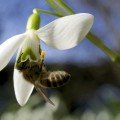Snowdrops for Bees!

With this cold winter full of arctic winds, polar vortexes and several feet of snow, it seems as if spring will never show it’s glowing face. It is usually around this time of year, late February and early March, that I find my honey bees foraging on Snowdrop flowers, the arching white beauties poking gracefully through the melting snow. With temps this week in the single digits and the ground still heavily covered in snow, I have yet to see these late winter gems. But in case you are luckier than I and happen to see a few snowdrops poking their heads through the ice, also keep a look out for the bees tucked neatly inside their blossoms, collecting some of the first pollen and nectar available to them this year.
Snowdrops are bulbous perennial flowers that are easy to grow year after year once they are established. Since they are blooming at a time in many areas when not much else is available, this gives bees and native pollinators a fresh source of nectar and pollen in late winter before spring has officially sprung. Honey bee colonies at this time are actively raising brood and eating through their pollen stores from the previous year, so access to fresh pollen to make bee bread, which they feed to their increasing number of young, is very helpful for them. In some locations, this may be the only food source available to them at this time of year.

Depending on the variety, Snowdrops can grow in planting zones 3-9, and are a hardy winter blooming flower. You can buy snowdrop bulbs and plant them in the fall for the following year, but be sure to plant them quickly as the bulbs can dry out and die. If you would like to plant some in the spring, you can buy these plants “in the green” with their leaves and flowers showing. Snowdrops prefer well draining soil and partial shade and grow great under deciduous trees and shrubs in a woodland environment with plenty of humus. They also grow well in pots and containers. For more information about snowdrops and planting snowdrops for bees please see Snowdrops: Winter Forage For Bees.
Other Posts You May Enjoy:
- Snowdrops: Winter Forage For Bees
- Blue Pollen, Honeybees and Siberian Squill
- Planting a Bee Friendly Garden
Snowdrops at Much Wenlock Priory Photo by Daniel.D. Slee via Creative Commons License.




